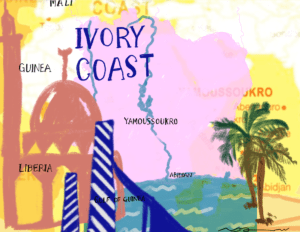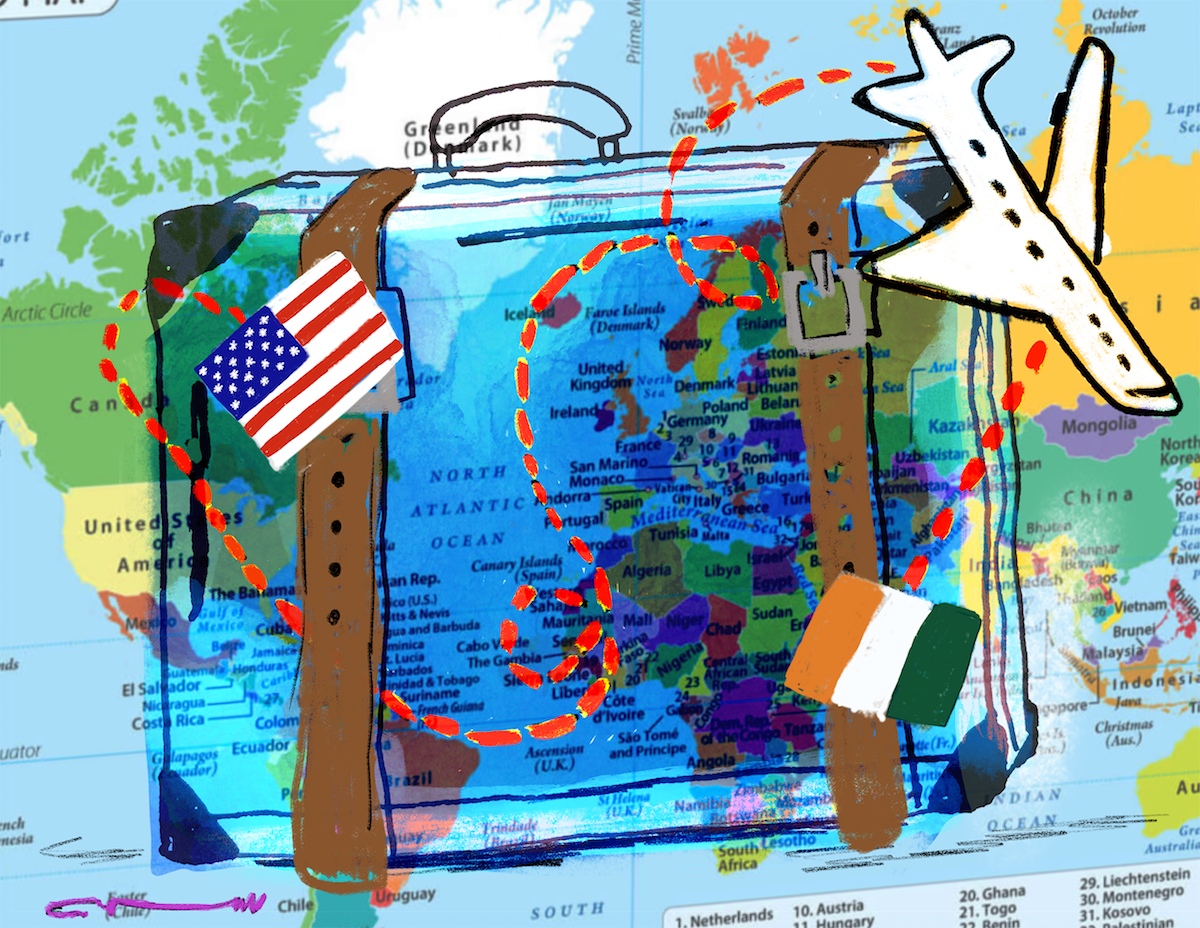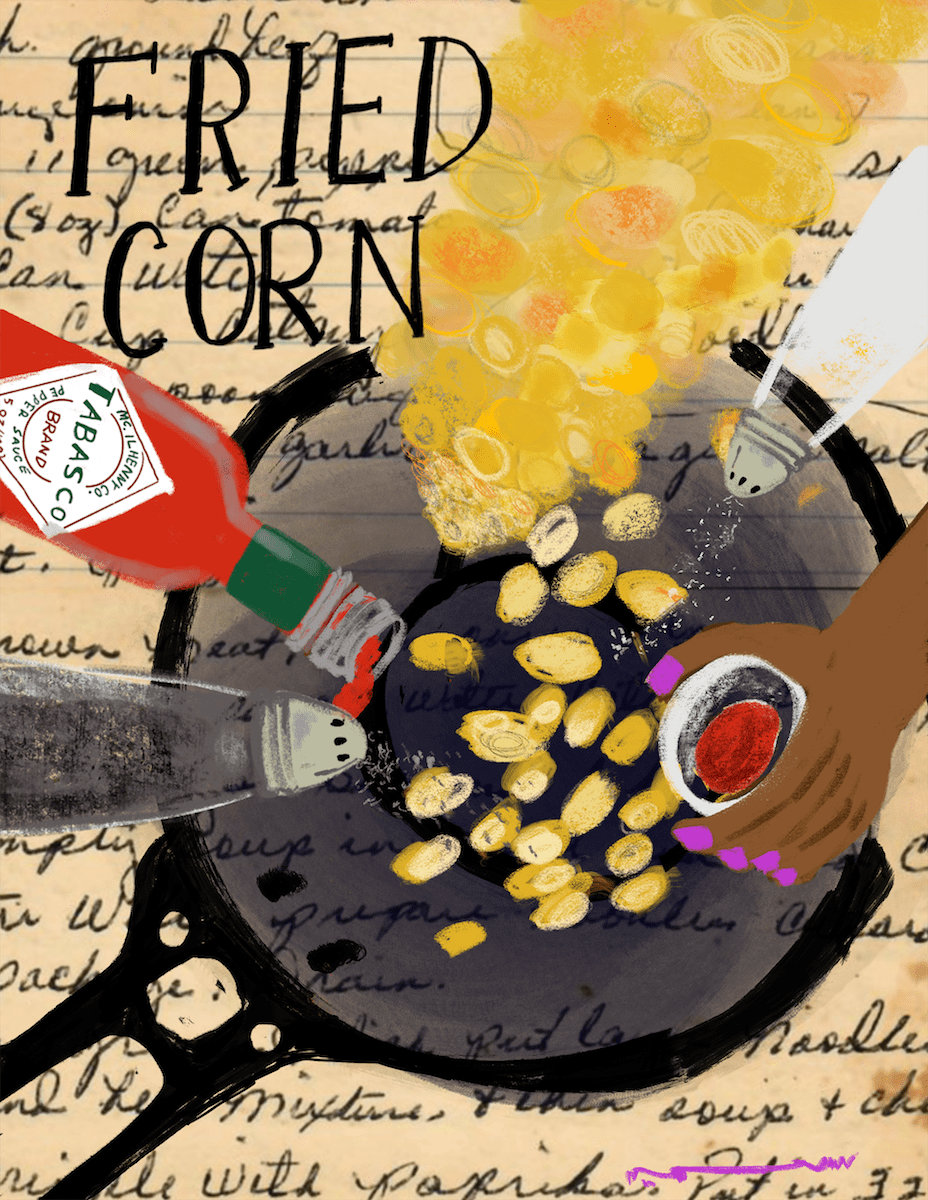
After seventeen hours of travel, my husband and I arrive at our destination: Abidjan, Côte d’Ivoire, the Paris of Africa. It’s hot when we land. Tropical hot. Dense and thick, not at all like the oven heat of summer I left back home in Chicago. As I unload my carry-on, the heat current flows through the cabin along with the smell of moist, loamy diesel and the patois of French, English, and other languages I can’t identify. I’m not worried because Eric has been living and working here for over a year, and I’d visited him in Abidjan. Yet, I’m still uncomfortable, not only because of the sweat dripping from my forehead and underarms. I am a newlywed, in a new country, where I don’t readily speak the language, and this time, I’m here to stay.
Inside the terminal, instead of a blast of air-conditioned frost there’s the same muggy heat. A few ceiling fans swat the humid air throughout the building. Eric’s job allows us to enter a special line for immigration and customs; we get our blue books stamped, exit the building, hail a taxi, and arrive at our rented house surrounded by a concrete wall in the Cocody neighborhood. Cocody is a middle class area: the house has a huge lawn in the back, but lacks a pool.
There is an enormous mango tree centered in the backyard. The tree is heavy with green-skinned fruit, the color and shape of large avocados; a few lay on the ground. I bend to pick one up to taste. The skin is smooth, the flesh firm. The house does have a live-in “housegirl” named Julie who, in exchange for free rent and a monthly salary, cleans the house and does laundry. She shakes her head. With my limited, high school French I ask, “Non? Quand sera prêt?” (When will it be ready?) Instead of replying, she holds up four fingers. I don’t know if she means days or weeks, but I leave the fruit alone.
Over the next few weeks, I do eat the kabob sandwiches from vendors at roadside stands. Small chunks of meat on sticks are roasted on empty oil drums lying horizontal in the dirt. Young men slice open a baguette and brush palm oil on the inside. The hot meat is added, sprinkled with spice; the vendor folds the sandwich, wraps it in foil, and hands it to me with a flourish “Voila, Madame. Merci.”
I never knew from what animal the meat came, and I never asked, preferring not to know. I figured it couldn’t be any worse than what was in a hotdog from one of Chicago’s Maxwell Street dives.
After a few weeks in Abidjan, I missed Chicago. I missed the sound of trains rumbling through the city’s streets, so different from the night noises of unknown animals in my Abidjan backyard. I missed the urban landscape, its garbage-laden alleys behind neat bungalow houses. I missed The Lake, whose waves undulated with the wind, smelling like smelt fish in the spring, topped with bobbing sail and motor boats in the summer. And I missed the scenery “downstate,” anywhere outside of Chicago, where by mid-July fields transformed into rolling waves of green corn stalks, all the way to where land meets sky, blue scratched by wisps of white clouds. The stalks are crowned with golden fluffs, evidence of where Ceres, the goddess of grain, touched the plants with her scepter. The ears of those plants are so sweet and juicy they’re called “peaches and cream.”
In Abidjan, you can purchase a grilled ear of corn in addition to your kabob sandwich for a few coins, “small money.” In its husk, this corn looks the same as what I’m used to back home, but when I pull back the leaves and take a bite, it crunches like peanuts. I ate most of it, knowing how rude and inappropriate it would be to waste food in front of people who may only have one ear of corn to eat for the entire day. Disappointed, I conclude that if I could get some raw ears of corn, I would make one of my favorite comfort foods of summer, fried corn, and in this small way revel in the tastes and memories of home.
It’s August by the time I feel comfortable going alone to the local grocery store to purchase the ingredients for fried corn. For one, I now have a car. Prior to this acquisition, Julie would walk to a nearby major street and hail me a taxi. I would then switch places with Julie, who went back to the house, in the back seat and go to the air-conditioned European supermarket where, although the aisles were laid out similarly and the brands on the shelves were recognizable, the prices were higher than back home. While I shopped, the driver waited with the meter running to take me back to the house. He wouldn’t necessarily take the most direct route and during the rides I feared being lost. Having enough money for a taxi to wait while I shopped and my Midwestern twang outed me as an American right away; the foreigner “tax” is exorbitant.
Although Julie said I sounded, “comme une bébé,” my French language skills had improved. With my hair in braids, my skin tanned, my Citroën, and my broken French, the initial assumption by people in the stores and outdoor markets is that I am from a nearby anglophone country, like Ghana or Nigeria. That doesn’t protect me from being ripped off, but the differential is not as high. Besides, I wouldn’t get any better communicating if I didn’t immerse myself in their culture.
I knew the recipe for fried corn from memory, recalling the voices of my mother and grandmother. The first step is to cut away the kernels in order to get to the heart of the ear. Heat will soften them and free their sweetness. Young ears, picked early in the season, are best. Older ears are tough, less flexible.
Next, scrape the milky pulp away from the ear. This pearly liquid is the heart of the recipe. If it’s too thin, you add flour to the mix; too thick, and you add milk. Spices—salt, pepper, sugar, paprika, and a touch of Tabasco—are sprinkled, not measured, into the mash. Then, for extra flavor, place some of each spice in the palm of your hand and then rub your palms together. Last, put your index finger over the bowl and pour Tabasco on it until it looks like it’s bleeding. Then stop.
Pour the batter into a pan, an iron skillet is best, and stir slowly so that the heat can spread evenly. The fire cannot be too hot or the dish will burn and have to be thrown out; too cold and the combination won’t gel and become whole. It takes time and patience to turn the corn from a yellow, bland starchy vegetable into a creamy, aromatic, tasty dish.
When it’s finished, the mixture in the pan looks and smells exactly as it should. I roast one of the scrawny, not-shot-up-with-hormones chickens on our grill and serve our new family of two.
“Voila,” I say to my husband.
He smiles.
The corn crunches like boiled peanuts. We threw away the fried corn and I cried at the loss. Eric wisely did not say “I told you so.” Instead, he took me out for crème glacée so I would feel better. The problem with the fried corn, I explained to him on the ride home, was that the variety cultivated in Côte d’Ivoire wasn’t the same as in the Midwest. I was going to have to grow my own.
I took his silence for agreement.
In September, I return to Chicago for a brief visit, and to shop for those available-only-in-America items. Before 9/11, there was no need to declare the treats in my checked luggage; I’d packed red and grape Kool-aid packets, Peter Pan peanut butter, Maybelline mascara, and some seeds: Burpee Triple Crown Hybrid Sweet Corn.
I believed it wouldn’t be that hard to grow corn. My great-aunt Lil had kept a garden in her backyard. As soon as school ended my siblings and cousins and I “worked” for her in her garden pulling up weeds, harvesting carrots and garlic and greens, picking tomatoes and cucumbers for pickling in great big glass jars. I would have no trouble growing a few stalks of corn.
The house in Abidjan not only had a housegirl; it came with a gardener, Yusef. I was becoming accustomed to having Yusef and Julie do things that I would normally do myself, were I at home. So, upon my return I asked Yusef to dig up the grass in a small section of the yard that got plenty of sunshine. Energized and excited, I threw myself into this new project, by standing in the hot sun, a bottle of water in my hand, watching as Yusef tilled the soil. I showed him the seeds.
He shook his head. “No, Madame,” he said. “Quelque chose ne pousse pas ici.”
This thing not [something] here. I ran for my dictionary and searched for the verb “pousser.” This thing will not grow here.
“Oui. Bien sur,” I stumbled over the words. “It will grow. Please, s’il vous plaît, do as I ask, fais ce que je demande.”
He moved away mumbling. The only words I understood were “American. Not blonde.”
I was stunned. I remember asking myself if I had translated correctly. I was a Black woman from the South Side of Chicago. That statement captured my roots and my identity. At home, I had never seen myself as an American because I had never been seen as an American.
Years before arriving in the Côte d’Ivoire, in 1988, I’d earned my Master’s degree and celebrated with a trip to Europe with a friend, Nancy, before we started our new jobs on opposite coasts of the United States. At that time, I didn’t have a passport. I’d never been outside of the US without my parents. Our first stop was in Athens and I was shocked by how quickly we were processed through customs.
“So this is how white folks roll,” I teased Nancy. “I’m glad I’m with you.”
“What?” she said. “Oh. That’s not why. Is it?”
I was about to explain when a man cut in. “You’re an American, too, young lady,” he said in a British accent. “In most places, that little blue book is more valuable than the Crown Jewels.”
I dismissed the gentleman’s hyperbole. It was way too easy to recall the times I had been followed through department stores by security guards as a teenager, my backpack the only one checked at the exit. Or, the fact that the same guard stopped me each and every time I entered my father’s downtown office building, while numerous white people sailed past the desk with a wave. I trembled with the memories of those instances when I was pulled over because the officer thought my brake light wasn’t working.
In October, I was able to obtain a consulting contract with the American Embassy in Abidjan. Every evening after work I’d rush home to measure how high my corn stalks had grown. I was tickled when they were knee high even though it wasn’t July. I pointed out the progress to Yusef.
“Voila, monsieur,” I said with a wave and a smile. “ Ils poussent.”
He nodded and smiled back.
When ears appeared on the stalks I danced with anticipation. I imagined not only cooking it for dinner with my husband—I’d bring fried corn to a dinner party and share the story of my small, productive field. I was finally going to fit in in this foreign country.
A week before Thanksgiving, I saw a tuft of pale yellow silk peeking out of the tips of the ears. They were ripe! I changed out of my work clothes and returned to the backyard. As if I were ripping bright green wrapping paper off of a Christmas present, I tore off an ear, pulled back the husk and removed the silk to reveal the kernels.
They were black, covered with a fuzzy mold.
What could have happened? There had been plenty of sun. Intermittent rain. The whole country was a tropical paradise. What more does corn need? Confused, I stroked the leaves to find evidence of an infestation of bugs or larvae, as I’d done with collard greens in Aunt Lil’s garden. The husks were soft and flexible, the texture of velvet. Healthy. Mystified, I pulled another ear off the stalk. More black kernels.
I heard Julie and Yusef talking and laughing behind me. J’ai dit à la femme que ne serais pas.
I’d heard that phrase many times. He was saying, “I told her so.”
Frustration replaced confusion. As I pulled another ear and tossed it on the ground sweat pooled in my neck and elbow creases. “Stupid country,” I muttered not giving a damn whether Julie or Yusef hear me.
One of them spat, “Les Américains.”
I stopped, turned and stared, vibrating with anger, but said nothing. Both looked away.
I yanked another ear from the stalk, stripped the husk and silk, and slammed the black ear on the ground. Dust blew and added black, grainy ink to the rivulets of perspiration sliding down my arms. My glasses slipped on my nose, which was dripping with sweat and snot from the dirt that had blown into my nostrils.
Yank. Pull. Toss.
“Elle pense qu’elle peut contrôler la terre.” I understood this as well. “She thinks she can control the earth.”
Yank. Pull. Toss. My arms throbbed and ached. I tried to wipe my eyes on my sleeve. Yank. Pull. Toss.
Through my tears I told myself, “I am an American, damn it. And I want to go home.”
I looked down at my pile of ruined ears of corn. I spent so much time trying to offset my homesickness with this one familiar taste, trying to bring it to Abidjan where everything, everything was different, but I’d failed. My entire crop was spoiled. I stomped into the house to shower, where more tears blended with the water’s spray.
I was a senior in high school when the Iran hostage crisis took place. My family watched on television as the Black hostages were released first because the militants said they empathized with the way Black people were treated in the States. My parents joked that the US had already paid for its Black people and they weren’t going to ever pay a nickel more to ransom them.
I always knew that as a Black woman I’d never have the full rights and privileges of being an American when I was in America. But I’d hoped that like those hostages, I wouldn’t have to suffer the consequences of being an American in any other country, especially in a country in sub-Saharan Africa in the region where my ancestors were captured, stolen, and enslaved.
I was wrong.
The following week at a dinner party celebrating Thanksgiving, where the pageantry and mythology of America’s origin story is reinforced and celebrated, I brought a pan of brownies to share. I also told the story of my attempt at growing Midwestern sweet corn. My fellow countrymen and women roared with laughter at both my ignorance and arrogance that I could grow corn in the tropics of Côte d’Ivoire, a country a mere three hundred and fifty miles from the equator. I laughed as well.
I didn’t try to grow corn again. Yusef planted some hibiscus bushes in the area where my stalks used to be. I resigned myself to the fact that we were going to live here for at least two years—until the end of my husband’s contract—so I swapped my jeans, t-shirts, and shirtwaist dresses for skirts and dresses made in African fabrics, but in American styles. Although I started bargaining at the market, it was halfhearted, like a game where the odds were against me. I accepted that no matter what price I was charged for any item, it would include a foreigner tax. And, I carried my passport with me at all times.
After all, I am a Black woman from the South Side of Chicago, but I was born in America.
***
Rumpus original art by Sumayya Ansari.







